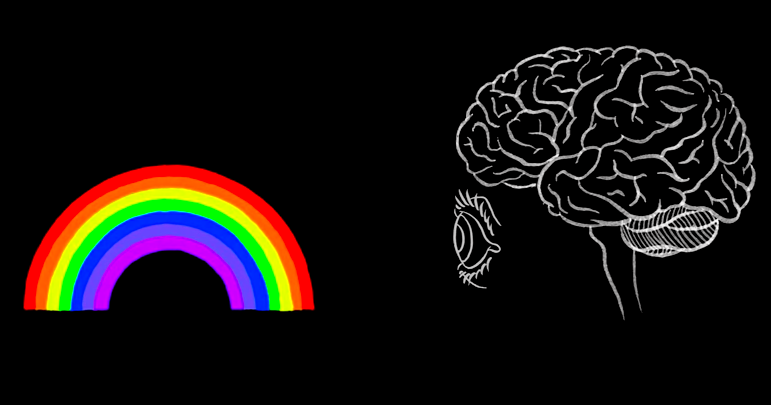(单词翻译:单击)
You might have heard that light is a kind of wave
你可能听过光是一种波,
and that the color of an object is related to the frequency of light waves it reflects.
而物体的颜色取决于该物体反射出光线的频率。
High-frequency light waves look violet, low-frequency light waves look red,
高频率的光波看起来是紫色,低频率的光波看起来是红色,
and in-between frequencies look yellow, green, orange, and so on.
而且两者中间的频率看起来可能是黄色、绿色、橘色等颜色。
You might call this idea physical color because it says that color is a physical property of light itself.
你可以说这是物理性的颜色,因为它表示光的颜色源自于本身属性。
It's not dependent on human perception.
和人类解读能力没有关系。
And, while this isn't wrong, it isn't quite the whole story either.
虽然这并非错误,但是不能完全解释人如何辨别颜色。
For instance, you might have seen this picture before.
举例而言,你可能看过这张图。
As you can see, the region where the red and green lights overlap is yellow.
如你所见,红色和绿色光叠加看起来是黄色。
When you think about it, this is pretty weird.
但如果你仔细思考,就会觉得怪怪的。
Because light is a wave, two different frequencies shouldn't interact with each other at all,
因为光具波动性,两种不同频率的光波不应该会有交互作用,
they should just co-exist like singers singing in harmony.
它们应该像是合唱演出般共同存在。
So, in this yellow looking region, two different kinds of light waves are present:
所以,在你看起来是黄色的区域有两种光波存在:
one with a red frequency, and one with a green frequency.
一种是红光光波,另一种是绿光光波。
There is no yellow light present at all.
但这里并无黄光光波的存在。
So, how come this region, where the red and green lights mix, looks yellow to us?
那为什么这个红色和绿色迭加的区域看起来会是黄色呢?
To understand this, you have to understand a little bit about biology, in particular, about how humans see color.
要了解这个现象,必须先了解生物学,尤其是关于人如何看到颜色的部分。
Light perception happens in a paper-thin layer of cells, called the retina, that covers the back of your eyeball.
光由人类眼球底部薄薄一层被称为视网膜的细胞所接收。

In the retina, there are two different types of light-detecting cells: rods and cones.
在视网膜上有两种感光细胞,杆状细胞和锥状细胞。
The rods are used for seeing in low-light conditions, and there is only one kind of those.
其中杆状细胞在低亮度时负责接收,而且只有一种。
The cones, however, are a different story.
而锥状细胞就有所不同了。
There three kinds of cone cells that roughly correspond to the colors red, green, and blue.
我们有三种锥状细胞,他们分别对应红色、绿色和蓝色。
When you see a color, each cone sends its own distinct signal to your brain.
当你看到颜色时,不同的锥状细胞会将不同的信号送向你的大脑。
For example, suppose that yellow light, that is real yellow light, with a yellow frequency, is shining on your eye.
举例而言,假设有一道真正具有黄色频率的光线射入你的眼睛。
You don't have a cone specifically for detecting yellow,
你并没有专门负责接收黄光的锥状细胞,
but yellow is kind of close to green and also kind of close to red,
但是因为黄色与绿色及红色相近,
so both the red and green cones get activated, and each sends a signal to your brain saying so.
所以负责红色和绿色的锥状细胞会被活化,分别传送信号到你的大脑。
Of course, there is another way to activate the red cones and the green cones simultaneously:
当然,有另一种方式可以造成负责红色和绿色的锥状细胞同时被启动:
if both red light and green light are present at the same time.
那就是红色和绿色光同时抵达,
The point is, your brain receives the same signal,
这时候脑部会收到相同的信号,
regardless of whether you see light that has the yellow frequency
不论是接受一束黄光,
or light that is a mixture of the green and red frequencies.
或是由红光和绿光所混成的光线,都是一样的。
That's why, for light, red plus green equals yellow.
这就是为什么对光线来说,红色加绿色就成了黄色。
And, how come you can't detect colors when it's dark?
那为何你无法在黑暗中辨别色彩呢?
Well, the rod cells in your retina take over in low-light conditions.
这是因为在低亮度的状况下是由视网膜上的杆状细胞接受感光。
You only have one kind of rod cell, and so there is one type of signal that can get sent to your brain: light or no light.
但是你只有一种杆状细胞,所以它只能送出一种信号,告诉你的大脑是亮还是暗。
Having only one kind of light detector doesn't leave any room for seeing color.
因为只有一种侦测器,所以没办法侦测看到的颜色。
There are infinitely many different physical colors, but, because we only have three kinds of cones,
物理颜色近乎无限多种,而我们只有三种锥状细胞,
the brain can be tricked into thinking it's seeing any color
大脑会认为看到了所有的色彩,
by carefully adding together the right combination of just three colors: red, green, and blue.
通过将红、绿、蓝三种颜色的信号相加。
This property of human vision is really useful in the real world. For example, TV manufacturing.
人类视觉原理在真实世界中十分有用。例如电视机的制造。
Instead of having to put infinitely many colors in your TV set to simulate the real world,
与其要放进无限种颜色的光源以仿真真实世界的色彩,
TV manufacturers only have to put three: red, green, and blue, which is lucky for them, really.
电视制造商只需要用到三种光源:红、绿、蓝。这对他们来说真是太幸运了!


